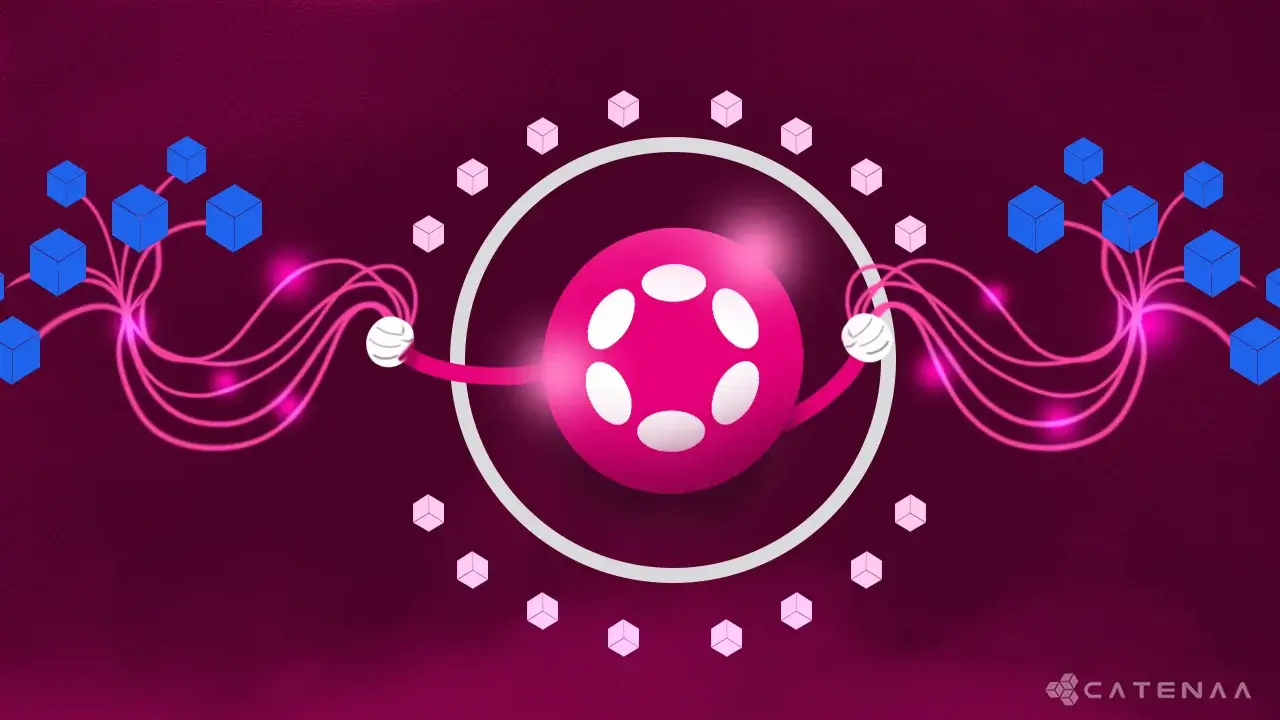Basics of Polkadot and its Significance
Polkadot could be considered a technology that stands out as a breakthrough in the rapidly developing field of blockchain technology. It is an open-source project that is developed and maintained by a community of contributors. The project is governed by the Web3 Foundation, the non-profit organization founded to promote Web3 technologies.
Imagine that you have a few different sets of toy blocks. You can use these blocks to build all sorts of things, like houses, cars, and even robots. But what if you want to build something that is bigger or more complex? You might need to combine blocks from different sets, but if those different sets of blocks are incompatible, a solution is needed to make them work together.
Polkadot Tech is like a system of toy blocks that are designed to be interconnected. Each block is a separate blockchain, and each blockchain can do its own thing. But the blocks are also connected so that they can work together. This means you can build bigger and more complex things than you could with a single blockchain.
For example, you could build a system allowing people to exchange data between blockchains. Or you could build a system that allows people to vote on decisions that affect multiple blockchains.
The idea behind Polkadot Tech is to make it easier to build and use blockchain applications. By connecting different blockchains together, Polkadot Tech makes it possible to create more powerful and versatile applications than anything possible with a single blockchain.
Polkadot’s exceptional focus on interoperability, however, is what distinguishes it from other blockchain networks. Polkadot allows different blockchains to communicate and exchange information erasing the walls that formerly separated them.
Polkadot does this with the help of Parachains, which serve as separate, specialized chains connected to the main Polkadot network.
Understanding Polkadot’s fundamentals will help you fully comprehend its importance in unleashing the full potential of blockchain technology and laying the foundation for a more inclusive and connected digital future. 1

The Core Concepts: Relay Chain, Parachains, and Bridges
The Relay Chain and Parachains are the two key components of Polkadot’s design. The Relay Chain oversees the security and consensus procedures that keep Polkadot operating efficiently, acting as the network’s backbone. It serves as the primary node, managing communication amongst many Parachains.
Contrarily, independent chains known as Parachains operate concurrently with the relay chain. They have distinctive qualities and uses that cater to various use cases and particular requirements. These Parachains’ ability to interact with one another and the Relay Chain creates a very adaptive and flexible ecology. This clever layout guarantees scalability and also improves security and general effectiveness.
The capability to interact across networks is a game-changer in the dynamic world of blockchain. Polkadot does this through Bridges, which enables frictionless connectivity between Polkadot and other blockchain networks. By serving as connectors, the bridges allow resources and data to move easily across networks that may use various protocols and consensus procedures. This cross-chain connectivity makes a vast array of opportunities possible, enabling users to easily access services and move assets across various blockchain ecosystems. 2
How Polkadot Solves Scalability and Interoperability Issues
Scalability, or being able to manage an increasing number of transactions without losing speed or efficiency, is one of the most important issues facing the blockchain community. This problem is addressed head-on by Polkadot’s creative sharding strategy. The blockchain network is “sharded,” or divided into smaller, easier-to-manage chunks. Because each shard may handle its own set of transactions separately, parallel processing is made possible and the network’s capacity is greatly increased. With the help of this horizontal scalability technique, Polkadot can manage several transactions at once, preventing bottlenecks and enhancing user experience.
Due to their vertical scaling strategy, which involves using a single chain to process all transactions, traditional blockchains sometimes have restrictions. However, Polkadot welcomes horizontal scaling by using a number of Parachains. Each Parachain runs independently and focuses on a separate application, resulting in a strong, linked network. Through horizontal scaling, developers may create custom Parachains to meet their particular requirements while also improving throughput overall. Polkadot’s horizontal scaling strategy provides a viable option to support the constantly increasing ecosystem as demand for blockchain technology rises.
A vital pillar that Polkadot skillfully delivers is blockchain interoperability. Polkadot dismantles the compartmentalized character of diverse networks by permitting seamless connection across numerous blockchains. Regardless of the native protocols of several blockchains, Polkadot enables safe and effective data transport and asset exchange with its smart Bridges and Relay Chain. This cross-chain compatibility encourages teamwork, makes cross-platform transactions easier, and broadens the possible applications of blockchain technology. 3
The Role of DOT Tokens in the Polkadot Ecosystem and How to Participate in Governance
The DOT tokens, which are the Polkadot ecosystem’s native tokens, are its fundamental building blocks. These tokens perform a variety of crucial tasks that are necessary for the general well-being and performance of the network. First and foremost, DOT tokens serve as the Polkadot network’s native currency, allowing payments and value transfers across platforms. Their importance goes much beyond simple transactions, however.
Staking, in which token owners lock up their DOT tokens as collateral to support the network’s security and consensus procedures, is one important use of DOT tokens. Participants actively participate in the process of creating blocks and validating transactions by staking their tokens to become validators or nominators. Nominators choose validators and get a portion of their staking rewards, while validators produce new blocks and maintain the network’s integrity. A decentralized and strong ecosystem is promoted by this staking structure, which encourages token holders to actively engage in network governance and maintenance.
Having DOT tokens also gives one the ability to take part in governing the Polkadot network. Token owners have the ability to suggest and vote on protocol updates, modifications, or enhancements thanks to an advanced governance system. The platform becomes fully decentralized and sensitive to the needs and aspirations of its users thanks to this democratic method, which gives the community the ability to drive the platform’s development. To ensure the network’s ongoing expansion and improvement, the governance approach promotes open dialogue, reaching agreement, and teamwork.
DOT token holders may easily participate in the administration of the Polkadot network. Token holders may participate in decision-making by submitting their ideas for network enhancements or casting votes on current proposals using their staked DOT tokens. The quantity of tokens they have staked equates to the weight of their vote. Furthermore, DOT token owners have the option to assign their tokens to trustworthy validators, enabling them to participate in governance without maintaining a validator node themselves. 4
Prominent Use Cases: DeFi, Supply Chain Management & More
Decentralized Finance (DeFi) has become more popular in the blockchain arena, and Polkadot has already established itself as a leading platform for hosting a variety of DeFi apps. Thanks to its scalable and interoperable design, Polkadot offers developers a fertile environment to create a wide variety of financial services without the constraints sometimes seen on single-chain platforms.
Polkadot’s ecosystem enables smooth interaction between various DeFi initiatives and expands access to financial services via a variety of decentralized exchanges (DEXs), lending platforms, yield farming, and stablecoins. The security and governance features of the network further boost the dependability and transparency of these DeFi applications, making Polkadot a desirable environment for financial innovation.
The supply chain sector is another area that notably benefits from Polkadot’s capabilities. Supply chain management tools on Polkadot may follow a product’s path from its point of origin to the final consumer by exploiting the interoperability capabilities of the network. Transparency and traceability increase stakeholder confidence, cut down on fraud, and guarantee legal compliance. Sharding technology from Polkadot makes it possible to handle enormous volumes of data effectively, simplifying the management of intricate supply chain networks. Additionally, Polkadot’s ability to integrate diverse supply chain management systems via cross-chain communication enables smooth data exchange and industry cooperation. Decentralized Polkadot reduces the possibility of data breaches and manipulation by helping to safeguard important supply chain data.
Polkadot’s adaptable ecosystem offers many opportunities for other use cases outside of DeFi and supply chain monitoring. This includes building decentralized social media platforms prioritizing user privacy and content ownership, developing original NFT (Non-Fungible Token) marketplaces for digital art and collectibles, and supporting IoT (Internet of Things) applications that demand secure and effective data exchanges. Polkadot is the perfect platform for fostering creativity across a range of sectors because of its scalability, interoperability, and active developer community.5
Future of Polkadot and Its Impact on The Blockchain Industry
The prospect for Polkadot is clearly bright as we look to the future of blockchain technology. Polkadot has established itself as a major player in the blockchain industry with its distinctive architecture and cutting-edge features, and its growth potential is nothing short of amazing.
The capacity of Polkadot to draw in and support a wide variety of initiatives inside its ecosystem will be one of the key factors in determining its future success. We can anticipate an increase in creative applications and use cases across several sectors as more developers and business owners come to appreciate the advantages of Polkadot’s scalable and interoperable infrastructure.
The simplicity of creating customized Parachains and the seamless connection between various blockchains will encourage initiatives that were previously constrained by scalability and interoperability issues to flourish inside the Polkadot ecosystem.
Polkadot is poised to attract interest from institutional players and conventional enterprises looking to use blockchain technology as it continues to develop and demonstrate its potential. The platform’s scalability, security, and governance features provide a solid basis for creating enterprise-grade solutions, which may accelerate blockchain adoption in various industries, including banking, supply chain, healthcare, and more. Because of its ability to solve real-world issues and provide concrete advantages to both companies and people, Polkadot is a leader in bringing blockchain technology into the mainstream.
Any blockchain project’s community is key to its success, and Polkadot has built a thriving and cooperative environment. The community will contribute to the platform’s continuing growth and enhancement as it expands. The open and democratic governance structure gives participants the chance to jointly build Polkadot’s future, assuring its flexibility to changing requirements and difficulties.6
Polkadot could emerge as a leading tech as we move towards a connected and effective decentralized future. With its capacity to scale, communicate across chains, and promote cooperation, Polkadot has the potential to transform whole sectors, propelling it to the forefront of innovation and building a more open and connected digital world.
- cointelegraph.com: https://cointelegraph.com/learn/what-is-polkadot-dot-a-beginners-guide-to-the-decentralized-web-3-0-blockchain[↩]
- Polkadot: www.wiki.polkadot.network[↩]
- Cryptopolitan: www.cryptopolitan.com[↩]
- Cryptoadventure: www.cyrptoadventure.com[↩]
- cryptobriefing.com: https://cryptobriefing.com/what-is-polkadot-introduction-dot/[↩]
- Businessinsider: www.businessinsider.com[↩]


